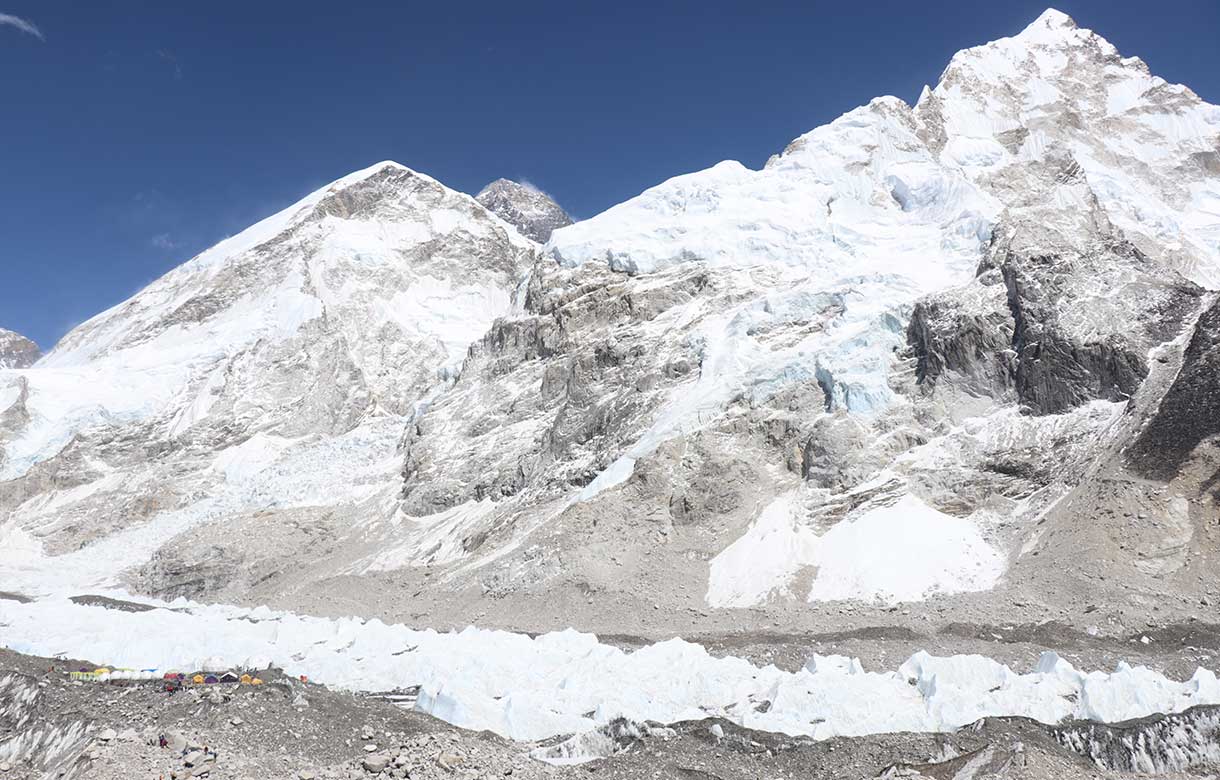Everest Base Camp sits at a staggering altitude of 5,364 meters (17,598 feet) above sea level, where the air is thin, the wind is sharp and the weather can change in minutes. For trekkers, understanding the Everest Base Camp average temperature is not just curiosity. As a matter of fact, it is a key part of preparation, safety and overall comfort. Temperatures at this elevation swing dramatically depending on the season, time of day and exposure.
During winter months, the landscape is frozen and silent; the biting cold of this cycle tests even experienced trekkers. Spring and autumn bring milder conditions, bright skies and clear mountain views, creating the most popular trekking windows. Summer, meanwhile, warmer, introduces monsoon clouds, rain and reduced visibility, which makes gear and planning even more important.
Knowing how the Mount Everest Base Camp average temperature shifts across months and between day and night will allow you to pack smarter, layer effectively and anticipate both challenges and moments of pure awe. From the frosty mornings at Gorak Shep to the sunlit afternoons near the Khumbu Glacier, temperature defines the experience at Everest Base Camp, shaping every step of this high-altitude adventure.
How Cold is Everest Base Camp?
Everest Base Camp sits at an altitude of around 5,364 meters (17,598 feet) above sea level. At this elevation, the air is thin, the oxygen level drops to nearly half of what it is normally at sea level and the temperatures feel harsh. So, how cold is Everest Base Camp situated at such a major elevation and with thin air? Even during the warmest months of the year, mornings and nights remain icy at this elevation. The Everest Base Camp average temperature during daytime ranges between -3°C to 10°C. Meanwhile, the night temperatures can easily drop to -10°C or even lower, depending on the season.
What makes Everest Base Camp feel even colder is not just the temperature reading on the thermometer but also the wind chill factor. The strong Himalayan winds sweep through the open plains near the Khumbu Glacier, making the real feel several degrees colder than the actual readings. At night, when the sun sets behind the towering peaks, the temperature drops sharply. The frost can form on tents and stones within minutes after sunset.
Trekkers often notice that the base camp Mount Everest temperature behaves differently. The dry air and low pressure make it pierce through layers, especially if you are not properly insulated. The rooms inside the teahouses are rarely heated. So, once you step away from the dining hall stove, you will immediately feel the bite of the mountain air.
Despite this, the cold at Everest Base Camp is manageable with proper gear and preparation. While doing the Everest Base Camp Trek, you need to bring warm base layers, a high-quality down jacket and a sleeping bag rated for at least -15°C to -20°C with you to keep yourself warm and protected from the high-mountain chill. During the day, sunlight can bring some warmth, especially when there’s no cloud cover. However, as soon as the sun dips, the temperature shifts dramatically, reminding you that you are standing at the foothills of the Himalayas.
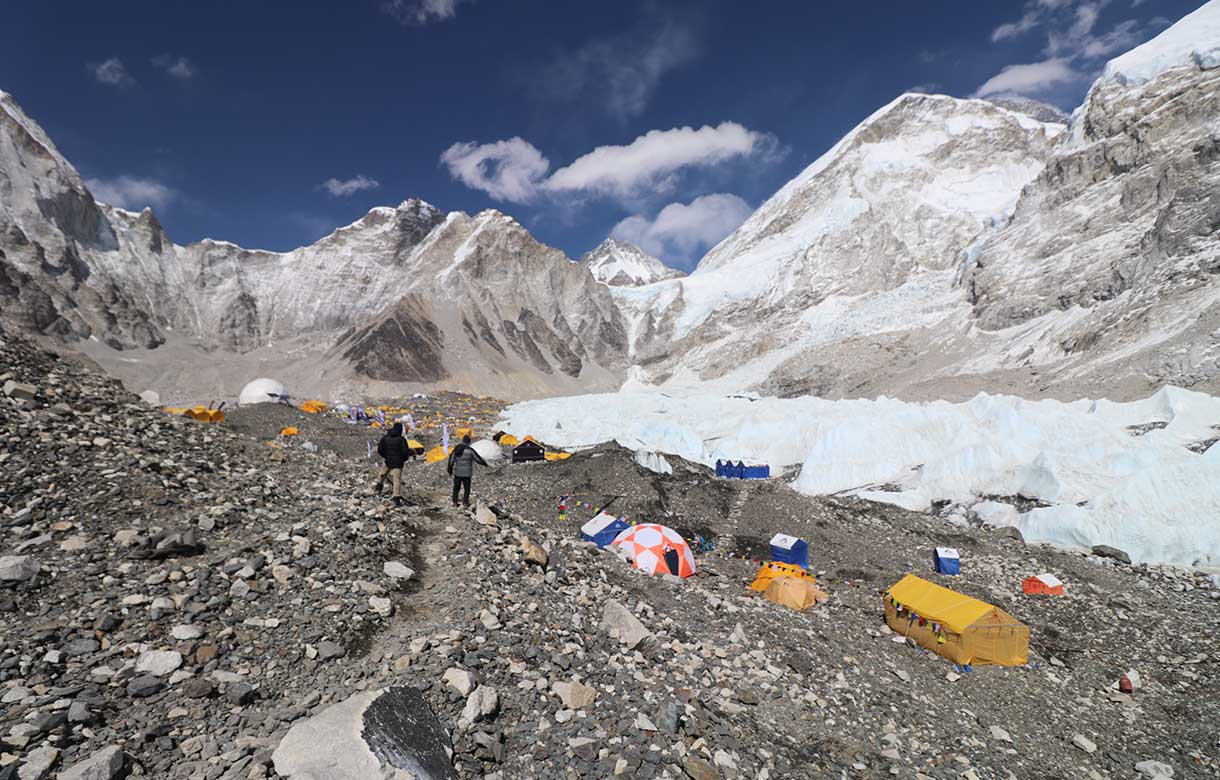
Factors That Affect Temperature at Mount Everest Base Camp
The Mount Everest Base Camp temperature does not stay constant for long and it is shaped by several natural forces that work together. From sudden weather changes to the sheer altitude, every factor contributes to how cold it actually feels up at the basin of the tallest mountain on the planet. So, understanding these conditions will help you prepare better for what awaits at high altitude.
-
Altitude and Elevation Gain
The biggest reason for the extreme average temperature Mt Everest Base Camp is the altitude itself. The camp is situated at 5,364 meters and for every 1,000 meters of elevation gain, the temperature drops roughly 6.5°C on average. As you climb higher from Lukla (2,800 m) to Everest Base Camp, you will notice a steady decline in warmth. This can be especially felt during the evenings and early mornings. The thin air at high altitude also holds less heat, which is why the nights get bitterly cold even after sunny warm days.
-
Seasonal Weather Patterns
The Everest region sees different seasons, which significantly influence temperature. The spring (March to May) and autumn (September to November) months on relatively mild and stable side. Meanwhile, winter (December to February) brings freezing climatic conditions and heavy snow that cover the trails. As for the monsoon (June to August), it raises humidity but keeps the temperature slightly warmer. Each season has its own unique weather patterns. And the temperatures you feel at the base camp will be determined by the window that you have chosen for your trek.
-
Wind and Exposure
The Mount Everest Base Camp Average Temperature is also massively influenced by the wind conditions. Wind plays a major role in how cold it feels at Base Camp. The Khumbu Glacier area is open and exposed, which allows strong gusts to sweep through the valley. Even when the thermometer reads around 0°C, a sharp Himalayan wind can make it feel like -10°C or colder. Wind also moves heat away from the body quickly. This is why good windproof clothing becomes essential at higher altitudes.
-
Sunlight and Radiation
The sunlight at high altitude is intense. During clear days, direct sun at the high altitudes can make the daytime temperature feel warm, especially during midday. But once the sun sets, the warmth vanishes instantly. This quick shift from sunlight to shadow is one of the most noticeable aspects of trekking in the Everest region. That is why a layering system is recommended during this high-altitude trek in the Himalayas.
-
Microclimates and Terrain
The Everest region is known for its microclimates, small and localized weather systems that can change within minutes. A sunny stretch in Namche Bazaar can quickly turn into snowfall at Dingboche or Everest Base Camp. The valleys, glaciers and slopes that are part of the terrain trap or release heat differently. This is the reason why the temperature can fluctuate sharply even within the same day, depending on where you are on the trekking trail.
Everest Base Camp Temperature by Month (Detailed Breakdown)
At 5,364 meters above sea level, the Everest Base Camp average temperature shifts dramatically across the year. Some months bring mild sunshine and calm air. Meanwhile, others blanket the trails in snow and muddy patches. Understanding these monthly variations will help you choose the right season for comfort, safety and stunning Himalayan views.
Below is a detailed breakdown of average Everest Base Camp temperature by month, along with what you can realistically expect in each window.
January (Mid-Winter Freeze)
Average Daytime Temperature: -10°C to -20°C
Average Nighttime Temperature: up to -25°C or lower
January is the coldest time of year at Everest Base Camp. During this month, the region remains wrapped in deep winter stillness, frozen streams, quiet trails and hard-packed snow underfoot. The days in this month can be bright and clear. But, as soon as the sun disappears, temperatures plunge well below -20°C. The Khumbu Glacier stays completely frozen and strong wind sweeps through the open valley. Only seasoned trekkers are recommended Everest Base Camp Trek in January. Although the journey can be challenging, this winter month rewards trekkers with unmatched visibility and serene solitude.
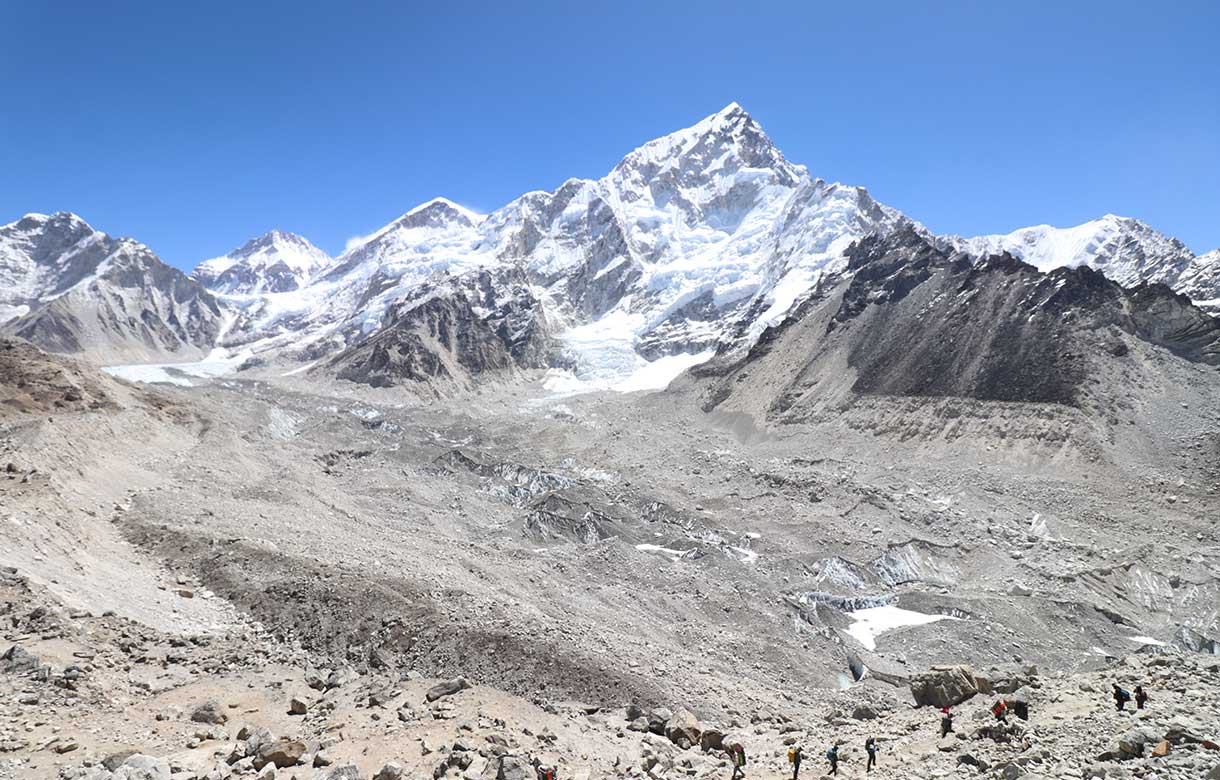
February (Still Harsh but Brighter Days)
Average Daytime Temperature: -5°C to -15°C
Average Nighttime Temperature: -15°C to -20°C
The month of February remains cold, though slightly less severe than January. By this month, days start to get a bit longer and sunlight feels stronger at altitude. The snow still lingers across higher sections and mornings start icy. But the afternoons can be relatively comfortable when the wind is calm. The trails also stay quiet and views of Everest and Ama Dablam are consistently sharp. With the right gear and mental preparation, this month offers a peaceful yet demanding trek across a frozen Himalayan landscape.
March (Early Spring Thaw)
Average Daytime Temperature: 0°C to 8°C
Average Nighttime Temperature: -5°C to -10°C
March marks the arrival of spring the spring season in the Everest region. The harsh cold begins to ease and snow starts to melt at lower altitudes. You can experience crisp mornings, sunny afternoons and gradually warming days. With the start of the spring season, trails come back to life as locals reopen lodges and rhododendron forests bloom lower down the route. The weather can be unpredictable at times, with a mix of bright skies and sudden snowfall. However, the overall conditions are far more manageable.
April (Mild and Stable Spring Weather)
Average Daytime Temperature: 2°C to 10°C
Average Nighttime Temperature: -3°C to -10°C
April is one of the best months to trek to Everest Base Camp as it is the midpoint of the spring season. In this month, the climate is mild, the skies are stable and the visibility is exceptional. Daytime walks feel comfortable with a light jacket and even if the nights remain cold, they are bearable. This is also the perfect window when the expedition teams begin to arrive at Base Camp, preparing for their summit attempts. Likewise, the snowline starts to disappear from the lower region, trails dry out and trekkers can enjoy a perfect mix of warmth, brightness and clear mountain panoramas.
May (Warmest Pre-Monsoon Conditions)
Average Daytime Temperature: 5°C to 12°C
Average Nighttime Temperature: up to -10°C
May brings the warmest pre-monsoon weather to the Khumbu region. The temperature rises noticeably during this point and the daytime sun feels strong on the glacier. The Everest Base Camp area gets busy with climbers, guides and porters as major expeditions prepare for summit pushes. Although days are comfortable, you should still expect chilly nights and occasional afternoon winds. This is the last stable window for the Everest Base Camp Trekking before the monsoon season begins.
June (Monsoon Transition)
Average Daytime Temperature: 5°C to 15°C
Average Nighttime Temperature: 0°C to minus degrees
The month of June marks the beginning of the summer monsoon. Still, during the early part of the month, the weather can still be decent. As the season progresses, the trails below Namche Bazaar become wet and slippery due to rain. Meanwhile, light snow may occur at the higher part of the trail. The temperature is warmer in this summer month. But visibility begins to suffer as clouds roll into the valleys. Although this is not the most ideal month for the EBC Trek, those who choose this period can expect lush scenery, blooming alpine flowers and quieter trails.
July (Peak Monsoon: Warm but Cloudy)
Average Daytime Temperature: 10°C to 16°C
Average Nighttime Temperature: 0°C to 6°C
This the peak point of the monsoon season with the highest humidity of the year. During July, heavy rain dominates lower elevations, while there is a probability of sleet and wet snow fall across the higher parts. The warmth makes the air feel less harsh, but the dampness and thick clouds will limit your visibility. Moreover, the trails are slippery and prone to landslides in some sections. However, the landscape turns lush and green, a rare sight in the Khumbu. There are also only a few trekkers on the trail during this time, making the experience peaceful but challenging.
August (Late Monsoon: Humid and Unpredictable)
Average Daytime Temperature: 10°C to 20°C
Average Nighttime Temperature: 0°C to 5°C
August continues the monsoon pattern during the initial part with misty mornings, afternoon rain and occasional thunder in the lower valleys. The temperature remains comfortable, but the humidity can make hiking feel tiresome. Cloud cover often obstructs the views of major peaks, though occasional clear breaks reveal dramatic views. By late August, the rainfall begins to ease, signaling the slow shift toward autumn. Trekkers who don’t mind wet conditions enjoy quiet trails and abundant greenery during this final month of monsoon season.
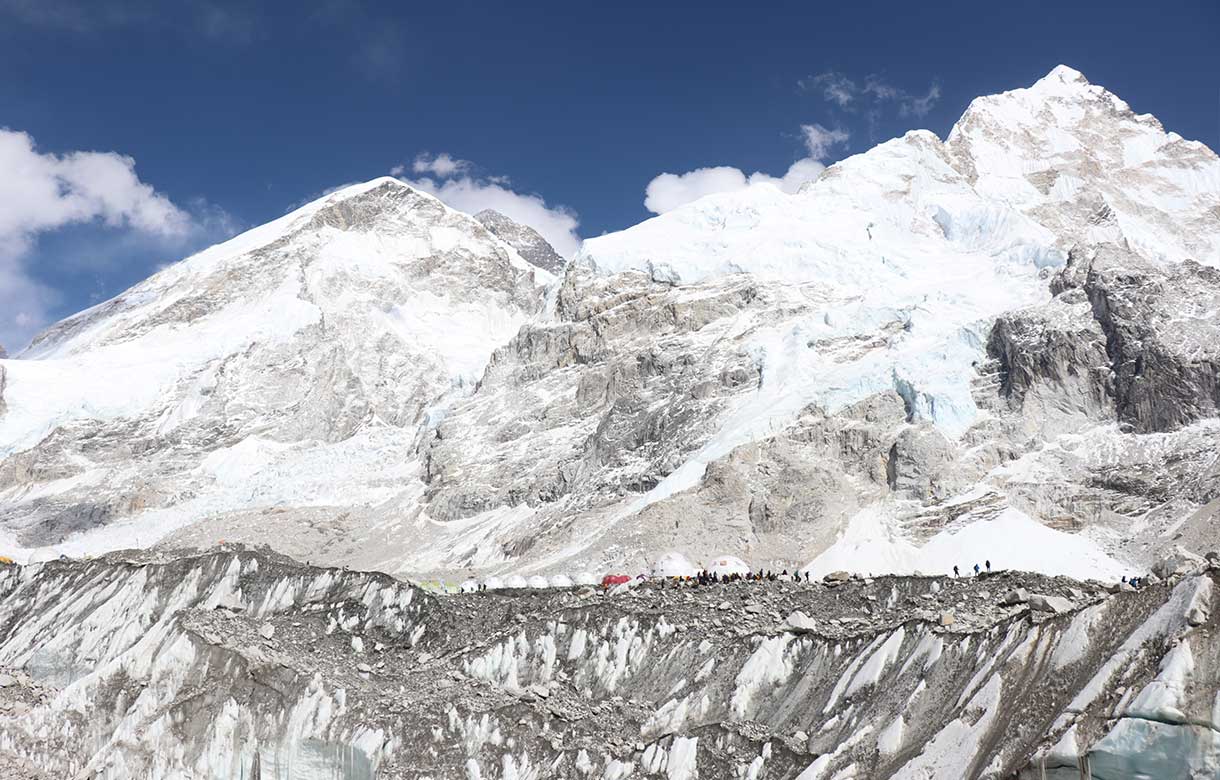
September (Post-Monsoon Clarity)
Average Daytime Temperature: 5°C to 12°C
Average Nighttime Temperature: 0°C or below
By September, the monsoon season withdraws and autumn begins to settle across the Himalayas. The air turns dry and crisp and the skies clear dramatically. Days are pleasant for walking with moderate warmth under the sun. However, nights grow colder as the month progresses, especially above 4,000 meters. September marks the return of ideal trekking conditions in the Himalayas with fewer clouds, strong visibility and fresh landscapes washed clean by the monsoon rain.
October (Autumn Perfection)
Average Daytime Temperature: 0°C to 5°C
Average Nighttime Temperature: -10°C to -15°C
October is the most popular trekking month in the Everest region as it is the peak period of the autumn season. During this month, you can expect the weather to be stable, air clear and temperatures to be perfectly balanced for hiking. Days are warm enough for steady trekking in light layers. Nights are cool, but they are not extreme. The views of Everest, Lhotse and Ama Dablam are at their absolute best during this window. Furthermore, trails are lively, lodges full and the overall atmosphere is vibrant and social in this peak trekking window. For most trekkers, October offers the ideal combination of comfort and breathtaking scenery.
November (Late Autumn Cooldown)
Average Daytime Temperature: 0°C to -10°C
Average Nighttime Temperature: -10°C to -15°C
November marks the end of the autumn season and the slow approach of winter. By this period, the air starts to get noticeably colder, especially after sunset at the higher altitudes. Still, days remain dry and the skies continue to offer excellent visibility. By late November, frost starts to form overnight and the region becomes quieter as crowds start to thin out. This is a good month for those who prefer solitude but can handle the returning cold.
December (Onset of Deep Winter)
Average Daytime Temperature: -10°C to -20°C
Average Nighttime Temperature: up to -25°C or lower
December marks the onset of deep winter in the Everest region. The days can still be sunny and peaceful, but after sunset, temperatures drop sharply. At the higher part of the trail, you will have to overcome frozen trails and icy water taps. Despite the chill, December has some of the clearest skies of the year. This month offers stunning panoramic views for those willing to take on the cold. Fewer crowds, dry air and absolute silence make it a rewarding yet demanding time to visit Everest Base Camp.
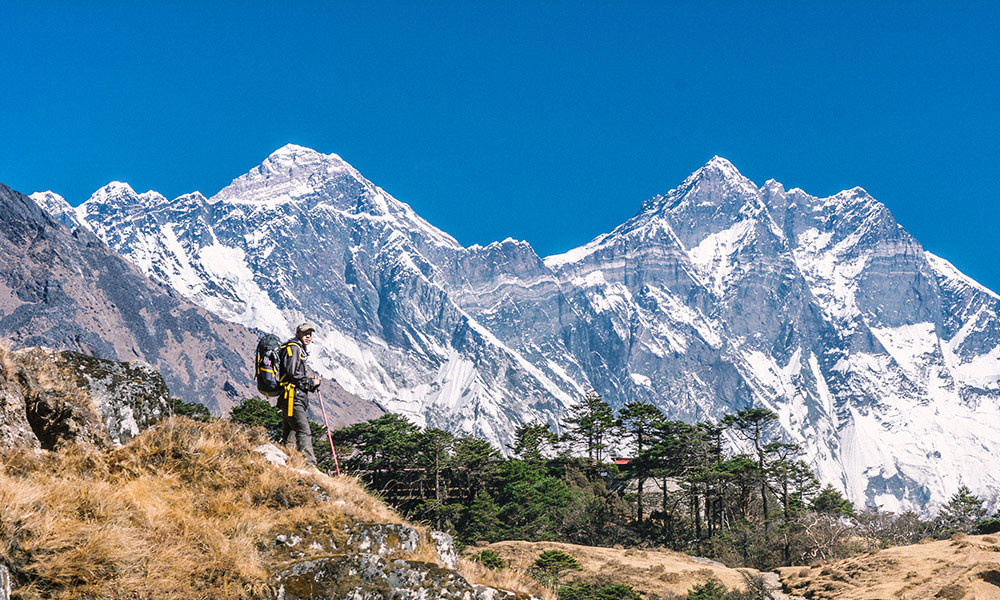
Daytime vs. Nighttime Temperatures at Everest Base Camp
The temperature at Everest Base Camp shifts dramatically between day and night. What feels manageable Mount Everest Base Camp average temperature under the midday sun can turn into biting cold after the sun dips behind the peaks. Understanding this temperature fluctuation between daytime and nighttime is crucial for all trekkers to prepare their gear, clothing and mindset for both conditions.
Daytime Temperatures
During the daytime when the sun is out, the Everest Base Camp temperature can range from -3°C to 10°C, depending on the season. In spring (March to May) and autumn (September to November), the sun can feel surprisingly strong due to the thinner atmosphere at high altitude. Thus, during the day, you can often hike comfortably in light thermal layers or even with just a fleece jacket.
However, the daytime warmth can often be deceptive. It is mostly from direct sunlight and not by the air itself. So, the moment clouds roll in or you step into the shade, the chill returns quickly. The wind sweeping off the Khumbu Glacier also keeps the air dry and crisp even when the sun feels warm.
Nighttime Temperatures
Once the sun sets, temperatures at the base camp drop fast. The average temperature Mt Everest Base Camp during the nighttime is around -5°C to -25°C, with the coldest conditions occurring between December and January. Compared to the daytime Everest Base Camp average temperature, this can feel like a drastic variation.
The thin air and lack of vegetation at the higher altitudes mean that there is little to trap heat. So, the warmth radiates away almost immediately after sunset. Even in warmer months, the nights can still be freezing and frost forms on the tents and teahouse roofs. That is why good-quality sleeping bags rated to at least -20°C are essential for comfort and safety, no matter which season you are doing this trek in.
Why the Temperature Drops So Fast?
The dramatic drop between day and night happens because of low air density and minimal moisture at high altitude. There’s less atmosphere to retain heat and once the sun’s energy is gone, the ground and air lose warmth rapidly. On clear nights, radiation cooling intensifies the cold; meanwhile, cloudy nights tend to stay slightly warmer.
What Trekkers Should Expect
Trekkers who have ventured a Himalayan route often find the contrast surprising. You will be walking in pleasant warmth during the day and layering up heavily after sunset as the cold intensifies. So, proper gear management becomes key:
- Light layers and sun protection during the day
- Insulated down jackets and thermal layers after dusk
- Warm sleeping systems for sub-zero nights
This day and night variation defines the Everest Base Camp experience. It is not just the altitude that tests endurance, its the sudden shift from sun to shadow, warmth to frost, often within minutes.
Packing and Clothing Tips for Everest Base Camp Temperature
Even though Everest Base Camp is a bucket-list trek rather than a technical alpine peak climbing, the high-altitude weather is unpredictable. Thus, proper gear ensures your trek is comfortable, safe and enjoyable, regardless of whether you are walking under strong sun, enduring biting wind, or facing sub-zero nights. Below is a detailed packing list broken down by categories, along with season-specific recommendations to make your journey comfortable and an unforgettable experience.
Clothing
- Base layers: thermal tops and bottoms
- Trekking shirts and t-shirts: moisture-wicking for daytime hikes
- Long-sleeve trekking shirt: for sun protection and layering
- Light fleece or sweater: for chilly mornings
- Down jacket: essential for cold nights and high-altitude stops
- Windproof jacket: protects against glacier winds and exposed ridges
- Rain jacket or poncho
- Trekking pants: durable, flexible for long hikes
- Lightweight casual pants: for teahouse evenings
- Hiking shorts: optional for warmer months
- Innerwear/undergarments: moisture-wicking recommended
- Neck gaiter or buff: protects against sun, wind and dust
- Sun hat or cap
- Gloves: lightweight for daytime, thick wool/insulated for nights
- Socks: trekking-specific thin and woolen/insulated layers
Seasonal Adjustments:
- Winter (December to February): Add extra mid-layer fleece, heavier thermal underlayers, thicker down jacket, insulated gloves, balaclava and hat covering ears
- Spring (March to May): Standard layers will be sufficient; bring sun hat and lighter gloves
- Monsoon (June to August): Waterproof layers are crucial for this season; quick-dry clothes, extra change of socks, lightweight rain pants
- Autumn (September to November): Similar to spring, but you should add midweight layers for cooler nights
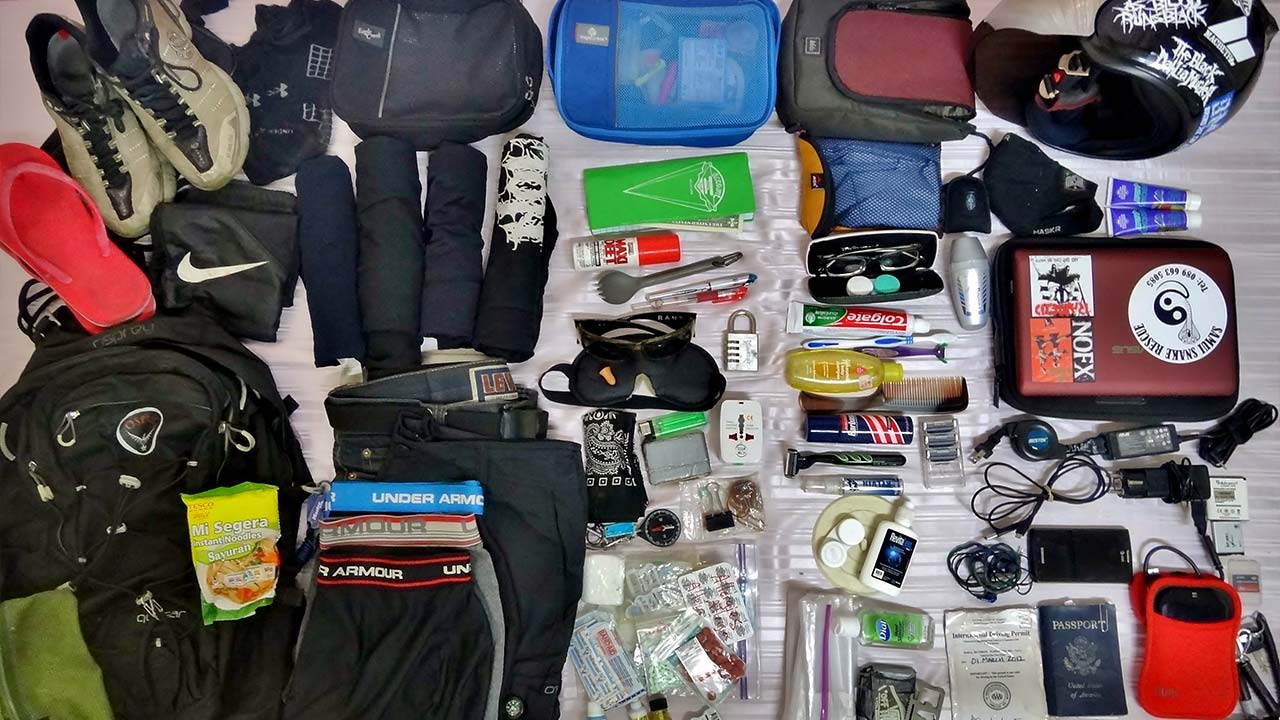
Footwear
- Trekking boots: insulated, waterproof, well-broken-in
- Sports or trainer shoes: for teahouse evenings or rest days
- Camp slippers or crocs: for comfort in lodges
- Trekking socks: thin for day, wool/insulated for nights
- Sock liners: for hygiene and to prevent blisters
Seasonal Adjustments:
- Winter: Bring extra thick socks, thermal liners and insulated waterproof boots are highly recommended
- Monsoon: Waterproof boots with a good grip
Gear and Accessories
- Backpack (30 to 40 L for day hikes)
- Duffel bag (carried by porter)
- Water bottle or hydration bladder
- Water purification system or tablets
- Trekking poles: helpful for uneven terrain
- Sunglasses with UV protection
- Headlamp or flashlight with extra batteries
- Power bank
- Universal adapter
- Trekking map, guidebook, GPS
Seasonal Adjustments:
- Winter: Carry hand warmers, an insulated water bottle
- Monsoon: Waterproof backpack cover, extra plastic bags for electronics
Personal Essentials
- Toothbrush and toothpaste
- Biodegradable soap and shampoo
- Light travel towel
- Sunscreen cream and lip balm (UV protection)
- Perfume and foot powder
- Hand sanitizer
- Toilet paper, tissue paper, wet wipes
- Insect repellent (more useful in spring and monsoon)
- Small first aid kit
- Personal medication
- Snacks and energy bars
- Reusable shopping bag
- Travel documents
- Cash in Nepali Rupees
Seasonal Adjustments:
- Winter: Include extra moisturizer and lip balm, high-calorie snacks
- Monsoon: Waterproof storage for essentials, insect repellent and anti-fungal foot powder
How Temperature Affects Trekking Experience and Safety?
Everest Base Camp Temperature is more than just a number on a thermometer. It directly influences your comfort, physical performance and safety. From the first steps in Lukla to the icy nights at Everest Base Camp, understanding how cold or warm conditions impact trekking is crucial for a successful and enjoyable trip.
-
Physical Performance
High-altitude cold slows your body’s metabolism and energy production. Even moderate daytime temperatures can feel exhausting when combined with thin air and steep climbs. The low temperature condition requires your body to burn more calories just to stay warm. This increases fatigue over long treks. Trekkers may also notice slower recovery times, stiffer muscles and heavier breathing during colder months. So, it is important for you to maintain proper layering and hydration to support energy levels. And make sure to schedule shorter hikes if needed during extreme cold.
-
Altitude Sickness Risk
Temperature itself does not cause altitude sickness, but extreme cold can amplify the symptoms. Chilly weather leads to dehydration through rapid breathing, while cold-stressed bodies are more prone to fatigue, headaches and poor circulation. All of these factors make Acute Mountain Sickness (AMS) worse. That is why there is a higher risk of altitude sickness in the colder months compared to the warmer ones. That’s why you need to acclimatize gradually, take breaks and avoid pushing too hard in frigid conditions.
-
Trekking Comfort
Temperature directly affects how enjoyable the trek feels. During the cold winter months, the trails are quiet and the views clear. But days require heavy gear and nights are extreme. Compared to that, spring and autumn have moderate temperatures, manageable nights and excellent visibility. Trekking in these seasons is also more comfortable and social. On the contrary, monsoon is warm, but wet and humid conditions reduce comfort. During this season, the trails are slippery and the mountain views are obscured. You need to choose trekking seasons carefully based on your tolerance for cold, crowds and wet conditions.
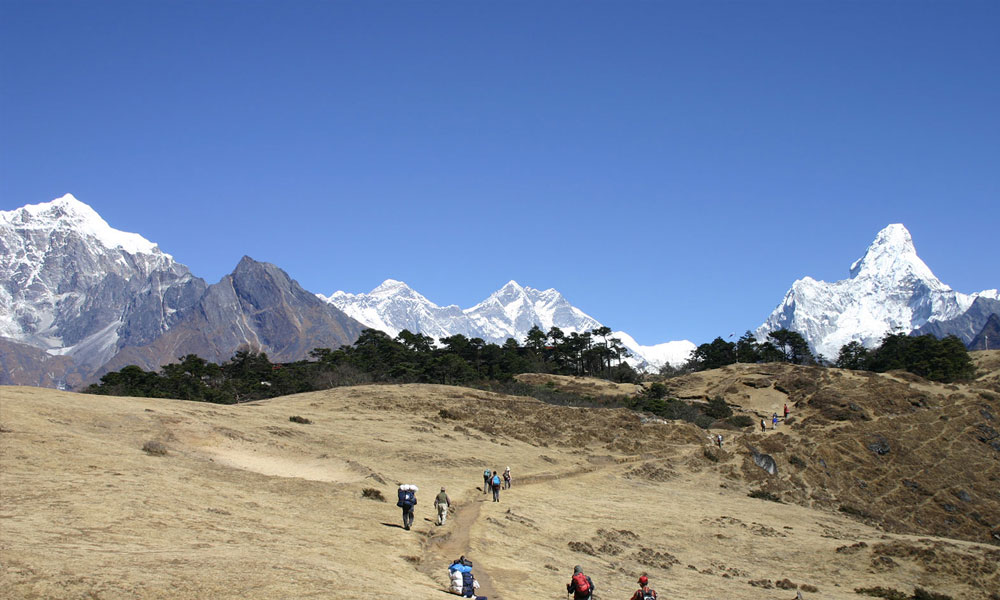
-
Camp and Teahouse Experience
Even in teahouses, nights can be freezing without adequate gear. At most teahouses, there is only a central heating system available (dining hall). Your rooms are not heated, so you will need to rely on your gear for warmth. Cold affects sleep quality, appetite and recovery, which are all vital for high-altitude trekking. So, you will need a sleeping bag with proper insulation for low temperatures and warm clothing. Prepare for nights to be colder than expected, and plan for extra layers inside teahouses.
-
Mental and Emotional Impact
Extreme cold temperatures can majorly impact your morale during the trek. Frustration, fatigue and irritability increase when temperatures are uncomfortable. In contrast, comfortable daytime conditions with well-managed layering boost confidence, motivation and overall enjoyment along the trek.
**Note: The Everest Base Camp temperature is not just about comfort, it shapes safety, stamina and overall trekking experience. Proper preparation, awareness about it and respect for high-altitude conditions are essential for a successful and memorable journey**

